

Compact Muon Solenoid
LHC, CERN
| CMS-PAS-EXO-16-043 | ||
| Search for pair-production of first generation scalar leptoquarks in pp collisions at $ \sqrt{s} = $ 13 TeV with 2.6 fb$^{-1}$ | ||
| CMS Collaboration | ||
| August 2016 | ||
| Abstract: A search for pair production of first generation scalar leptoquarks is presented, considering a final state containing two electrons and at least two jets, using proton-proton collision data at $ \sqrt{s} = $ 13 TeV. The data were recorded with the CMS detector at the LHC during 2015, and correspond to an integrated luminosity of 2.6 fb$^{-1}$. First generation scalar leptoquarks with masses less than 1130 (920) GeV are excluded for $\beta = $ 1.0 ($\beta = $ 0.5), where $\beta$ is the branching fraction of a leptoquark decaying to a charged lepton and a quark. | ||
| Links: CDS record (PDF) ; inSPIRE record ; CADI line (restricted) ; | ||
| Figures | |
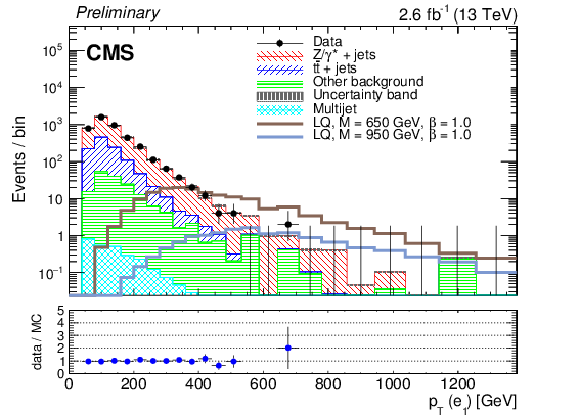
png pdf |
Figure 1-a:
Distributions of ${p_{\mathrm {T}}}$ for the two leading electrons and two leading jets in the events passing preselection. Two leptoquark signal mass hypotheses are shown in addition to the data and background predictions. The category denoted as ``Other background'' includes single top, W+jets, diboson, and $\gamma $+jets events. |
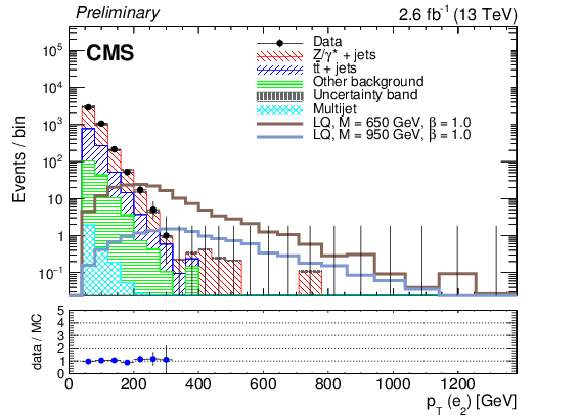
png pdf |
Figure 1-b:
Distributions of ${p_{\mathrm {T}}}$ for the two leading electrons and two leading jets in the events passing preselection. Two leptoquark signal mass hypotheses are shown in addition to the data and background predictions. The category denoted as ``Other background'' includes single top, W+jets, diboson, and $\gamma $+jets events. |

png pdf |
Figure 1-c:
Distributions of ${p_{\mathrm {T}}}$ for the two leading electrons and two leading jets in the events passing preselection. Two leptoquark signal mass hypotheses are shown in addition to the data and background predictions. The category denoted as ``Other background'' includes single top, W+jets, diboson, and $\gamma $+jets events. |

png pdf |
Figure 1-d:
Distributions of ${p_{\mathrm {T}}}$ for the two leading electrons and two leading jets in the events passing preselection. Two leptoquark signal mass hypotheses are shown in addition to the data and background predictions. The category denoted as ``Other background'' includes single top, W+jets, diboson, and $\gamma $+jets events. |
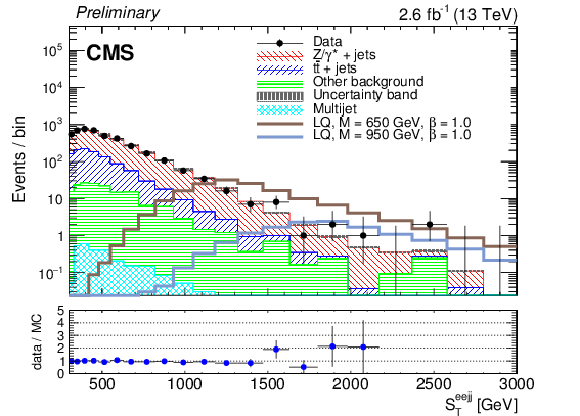
png pdf |
Figure 2-a:
Distributions of the final selection variables ${S_{\mathrm {T}}}$, $M_{ee}$, and $M_{min}(ej)$, in the events passing preselection. Two leptoquark signal mass hypotheses are shown in addition to the data and background predictions. The category denoted as ``Other background'' includes single top, W+jets, diboson, and $\gamma $+jets events. |

png pdf |
Figure 2-b:
Distributions of the final selection variables ${S_{\mathrm {T}}}$, $M_{ee}$, and $M_{min}(ej)$, in the events passing preselection. Two leptoquark signal mass hypotheses are shown in addition to the data and background predictions. The category denoted as ``Other background'' includes single top, W+jets, diboson, and $\gamma $+jets events. |

png pdf |
Figure 2-c:
Distributions of the final selection variables ${S_{\mathrm {T}}}$, $M_{ee}$, and $M_{min}(ej)$, in the events passing preselection. Two leptoquark signal mass hypotheses are shown in addition to the data and background predictions. The category denoted as ``Other background'' includes single top, W+jets, diboson, and $\gamma $+jets events. |
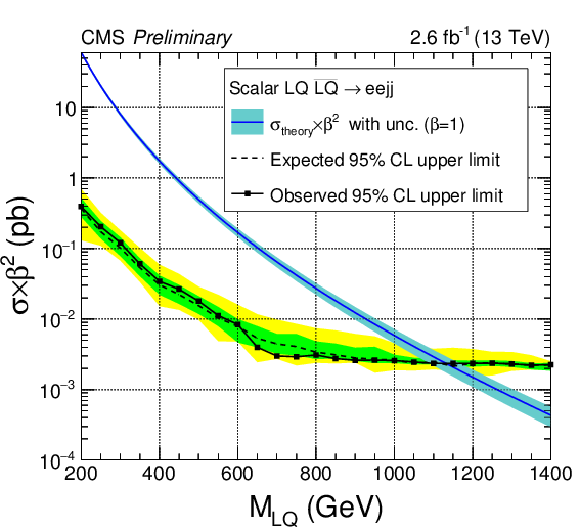
png pdf |
Figure 3:
Observed and expected upper limits for scalar leptoquark pair-production cross section times $\beta ^2$ at the 95% confidence level. The median (dashed line), 1$\sigma $ (green), and 2$\sigma $ (yellow) expected limits are shown. The theoretical prediction is varied by the adjusting the renormalization and factorization scales and combining with the PDF uncertainty, to producing the shaded band. |
| Tables | |
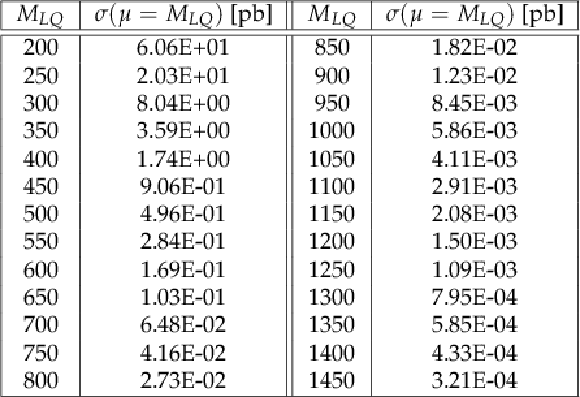
png pdf |
Table 1:
Scalar first-generation $LQ$ signal cross sections calculated at NLO. |
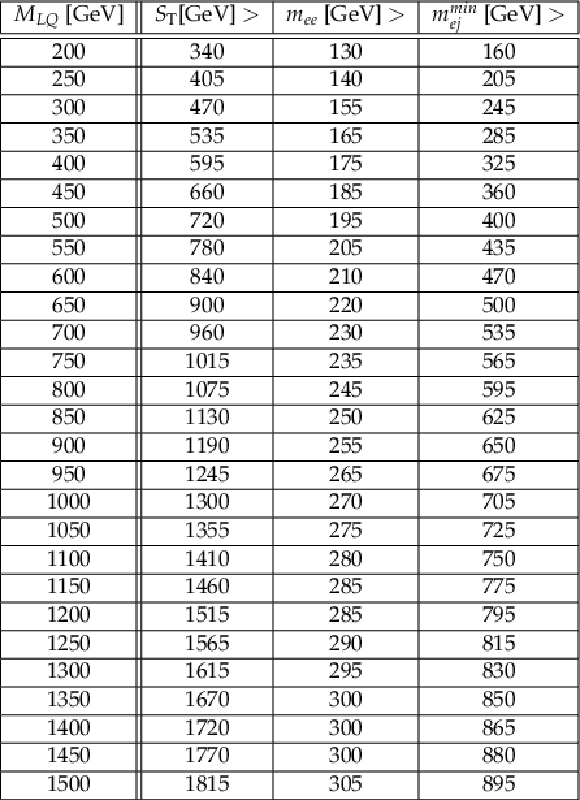
png pdf |
Table 2:
Optimized final selection thresholds for the $eejj$ analysis. |
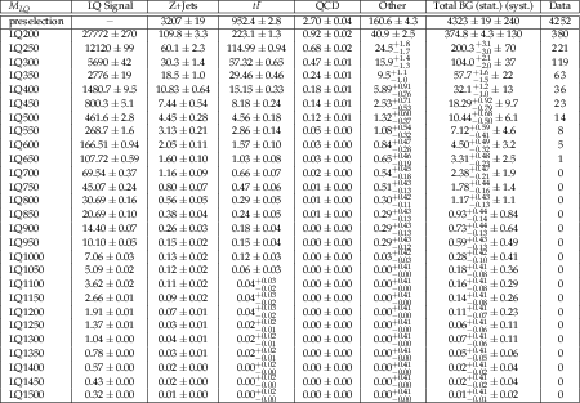
png pdf |
Table 3:
Event yields after the optimized $eejj$ selections for signal, observed data, and background predictions. All uncertainties are statistical except for the total background, where statistical and systematic uncertainties are reported separately. |
| Summary |
| A search for pair production of first generation scalar leptoquarks has been presented, based on pp collision data collected in 2015 at $\sqrt{s} =$ 13 TeV and corresponding to an integrated luminosity of 2.6 $\text{fb}^{-1}$. The search considers the leptoquark decay into a final state containing two electrons and two jets. After background prediction is complete, the selection thresholds are optimized using a scan of the full parameter space for each leptoquark mass point. At each set of optimized selection thresholds, the number of observed events agrees with the background expectation based on standard model processes. Limits at 95% confidence level are set assuming $\beta = $ 1, excluding first generation scalar leptoquarks with masses less than 1130 GeV, compared to 1140 GeV for the median expected limit. Mass limits are also obtained for $\beta = $ 0.5, in which case first generation scalar leptoquarks with masses less than 920 GeV are excluded, with a median expected limit of 910 GeV. This is the tightest CMS constraint on the first generation scalar leptoquark mass to date. |
| References | ||||
| 1 | B. Schrempp and F. Schrempp | Light Leptoquarks | PLB 153 (1985) 101 | |
| 2 | S. Dimopoulos and L. Susskind | Mass Without Scalars | Nucl. Phys. B 155 (1979) 237 | |
| 3 | H. Georgi and S. Glashow | Unity of All Elementary-Particle Forces | PRL 32 (1974) 438 | |
| 4 | J. C. Pati and A. Salam | Lepton Number as the Fourth Color | PRD 10 (1974) 275 | |
| 5 | J. L. Hewett and T. G. Rizzo | Low-energy phenomenology of superstring-inspired E$ _{6} $ models | PL183 (1989) 193 | |
| 6 | W. Buchm\"uller and D. Wyler | Constraints on SU(5)-type Leptoquarks | PLB 177 (1986) 377 | |
| 7 | O. Shanker | $ \pi $l2, Kl3, and K$ ^0 $-$ \bar{K^0} $ Constraints on Leptoquarks and Supersymmetric Particles | Nucl. Phys. B 204 (1982) 375 | |
| 8 | CMS Collaboration | Search for pair production of first and second generation leptoquarks in proton-proton collisions at sqrt(s) = 8 TeV | PRD 93 (2016), no. 3, 032004 | CMS-EXO-12-041 1509.03744 |
| 9 | ATLAS Collaboration | Search for scalar leptoquarks in $ pp $ collisions at $ \sqrt{s} = 13 $ TeV with the ATLAS experiment | Submitted for publication in New Journal of Physics | 1605.06035 |
| 10 | CMS Collaboration | The CMS experiment at the CERN LHC | JINST 3 (2008) S08004 | CMS-00-001 |
| 11 | CMS Collaboration | Performance of electron reconstruction and selection with the CMS detector in proton-proton collisions at $ \sqrt{s} = 8 $$ TeV $ | JINST 10 (2015) P06005 | CMS-EGM-13-001 1502.02701 |
| 12 | GEANT4 Collaboration | GEANT4: A simulation toolkit | NIMA 506 (2003) 250--303 | |
| 13 | T. Sj\"ostrand et al. | High Energy Physics Event Generation with PYTHIA 6.1 | CPC 135 (2001) 238 | hep-ph/0010017 |
| 14 | T. Sj\"ostrand, S. Mrenna, and P. Z. Skands | A Brief Introduction to PYTHIA 8.1 | CPC 178 (2008) 852--867 | 0710.3820 |
| 15 | R. D. Ball et al. | Parton distributions with LHC data | Nucl. Phys. B 867 (2013) 244--289 | 1207.1303 |
| 16 | M. Kramer, T. Plehn, M. Spira, and P. M. Zerwas | Pair production of scalar leptoquarks at the Tevatron | PRL 79 (1997) 341--344 | hep-ph/9704322 |
| 17 | M. Kr\"amer et al. | Pair production of scalar leptoquarks at the CERN LHC | PRD 71 (2005) | |
| 18 | P. M. Nadolsky et al. | Implications of CTEQ global analysis for collider observables | PRD 78 (2008) 013004 | 0802.0007 |
| 19 | F. Maltoni and T. Stelzer | Madevent: Automatic Event Generation with MadGraph | JHEP 02 (2003) 027 | hep-ph/0208156 |
| 20 | J. Alwall et al. | MadGraph/MadEvent v4: The New Web Generation | JHEP 09 (2007) 028 | 0706.2334 |
| 21 | S. Alioli et al. | A general framework for implementing NLO calculations in shower Monte Carlo programs: the POWHEG BOX | JHEP 06 (2010) 043 | 1002.2581 |
| 22 | CMS Collaboration | Muon Reconstruction and Identification Improvements for Run-2 and First Results with 2015 Run Data | CDS | |
| 23 | M. Cacciari, G. P. Salam, and G. Soyez | The anti-$ k_t $ jet clustering algorithm | JHEP 04 (2008) 063 | 0802.1189 |
| 24 | CMS Collaboration | Commissioning of the Particle-Flow Reconstruction in Minimum-Bias and Jet Events from $ \mathrm{ p }\mathrm{ p } $ Collisions at 7 TeV | CDS | |
| 25 | CMS Collaboration | Jet Performance in pp Collisions at 7 TeV | CDS | |
| 26 | CMS Collaboration | Determination of jet energy calibration and transverse momentum resolution in CMS | JINST 6 (2011) 11002 | CMS-JME-10-011 1107.4277 |
| 27 | G. Punzi | Sensitivity of searches for new signals and its optimization | eConf C030908 (2003) MODT002, [,79(2003)] | physics/0308063 |
| 28 | CMS Collaboration | CMS Luminosity Measurement for the 2015 Data Taking Period | ||
| 29 | J. Butterworth et al. | PDF4LHC recommendations for LHC Run II | JPG 43 (2016) 023001 | 1510.03865 |
| 30 | CMS Collaboration | Search for a Narrow Resonance Produced in 13 TeV pp Collisions Decaying to Electron Pair or Muon Pair Final States | CMS-PAS-EXO-15-005 | CMS-PAS-EXO-15-005 |
| 31 | A. L. Read | Modified frequentist analysis of search results (the $ CL_{s} $ method) | CERN-OPEN 2000-205, 2000 1st Workshop on Confidence Limits, CERN, Jan. 2000 | |

|
Compact Muon Solenoid LHC, CERN |

|

|

|

|

|

|